What helps PTSD Symptoms?
by Dana Terrell, LCSW, EAC
Have you experienced
- A motor vehicle accident?
- Violent crime? War combat?
- A sports injury or fracture?
- Diagnosis of a serious illness?
- A series of stresses?
- Domestic violence?
- A terrible loss or shock?
- Rape or sexual assault?
- High anxiety or panic?
- A bite from an insect/animal?
All of these events have the potential to cause PTSD symptoms, including panic or phobias. It is important to recognize PTSD symptoms (the PTSD rate for people with fractures is 52%) and to know that effective treatment is available.
PTSD Symptoms
There are 3 kinds of PTSD symptoms:
Re-experiencing symptoms
- Flashbacks (sudden, disturbing memories of the event)
- Nightmares
Avoidance symptoms
- Avoding places, people or other reminderrs of the event
- Fear of driving after an accident
- Emotional numbness
- Losing interest in what you have previously enjoyed, or other signs of depression
- Substance abuse or behavioral compulsions
Hyper-arousal symptoms
- Startle easily
- Feel tense or “on edge”
- Anxiety attacks
- Insomnia
- Anger problems
- Trouble getting along with others
The Cochrane Review and the World Health Organization both recommend all suffering from PTSD symptoms be offered either CBT or EMDR Therapy. The Cochrane Review is a Brisith service that review all medical research for the most efficacious treatments based on solid research.
Cognitive Behavioral Treatment (CBT)
CBT is a talk therapy that involves learning to identify your negative beliefs about yourself and the incident. It helps you to learn to think more positively, through therapy and homework practiced between sessions.
EMDR Therapy (Eye Movement Desensitization and Reprocessing)
EMDR Therapy helps the brain store memories in a more healthy way. It calms the intense emotional memories (see brain scan). It uses an eight step protocol. One of the steps includes the therapist guiding the client to do eye movements (or other gentle sensory methods of bilateral stiumulation of the brain) while the client is focused on aspect of the memory.

Brain scans before EMDR (top slide) reveal how the many PTSD symptoms affecting you look in the brain. This brain is working hard with a lot of distress. The bottom slide shows the same person’s brain after EMDR therapy is complete (bottom slide). EMDR therapy has been demonstrated by randomized control studies to work faster (in 1/3 to 1/2 the time of CBT), with far less homework, less talk and a lower drop out rate than CBT. Veterans studies have shown they definitely prefer a non-talk therapy with minimal homework assignments.

How do I choose a therapist?
Many CBT therapist can be located through a Google search of your community. Ask the therapist how much experience they have with PTSD symptoms, what their success rate is and within how many sessions.
It is important to know, in searching for an EMDR therapist, that many people self-advertise themselves as experts, but are not certified by the EMDR International Association (EMDRIA). The certification process involves receiving 20 hours of consultation on one’s practice of the complete EMDR protocol, plus taking 12 credits of advanced training every 2 years.
The people who achieve and maintain EMDRIA certification are dedicated to the highest standards in EMDR. That is why those are the only therapist invited to join this very helpful online directory: ComprehensiveTherapyApproach.com.
You are welcome to ask the EMDR Therapists how much experience they have with PTSD symptoms, what their success rate is and within how many sessions they can achieve freedom from a PTSD diagnosis.
If you find yourself experiencing PTSD symptoms, please get help sooner rather than later. Symptoms may not show up until a month, or even years after the event, when something “triggers” the memory that may have been pretty buried. That doesn’t matter. What does matter is that you seek competent help when you need it, because PTSD can be treated. If you are not getting the help you need in one therapy, try another.
Or try another therapist with better credentials. Like the brain scan photos, your brain can get back to its natural state of health. As many EMDR Therapy clients exclaim, “I am myself again!” or “I got myself back.”
This article is offered in a brochure form that can be printed out and offered at health clinics, emergency rooms, , addiction treatment programs, organizations and places of worship. 25% of the population have PTSD symptoms. Many are not aware that their symptoms make sense withing PTSD. Sometimes they feel like they are crazy. This degree of distress take ahold of their lives and the lives of all who care about them or interact with them regularly. This is the reason it is so important to get effective help.
Anyone is invited to access the pdf of the brochure and print it out to help people who could be stuck in trauma and want to get truly free of it. Please click on “PTSD Brochure” below:


